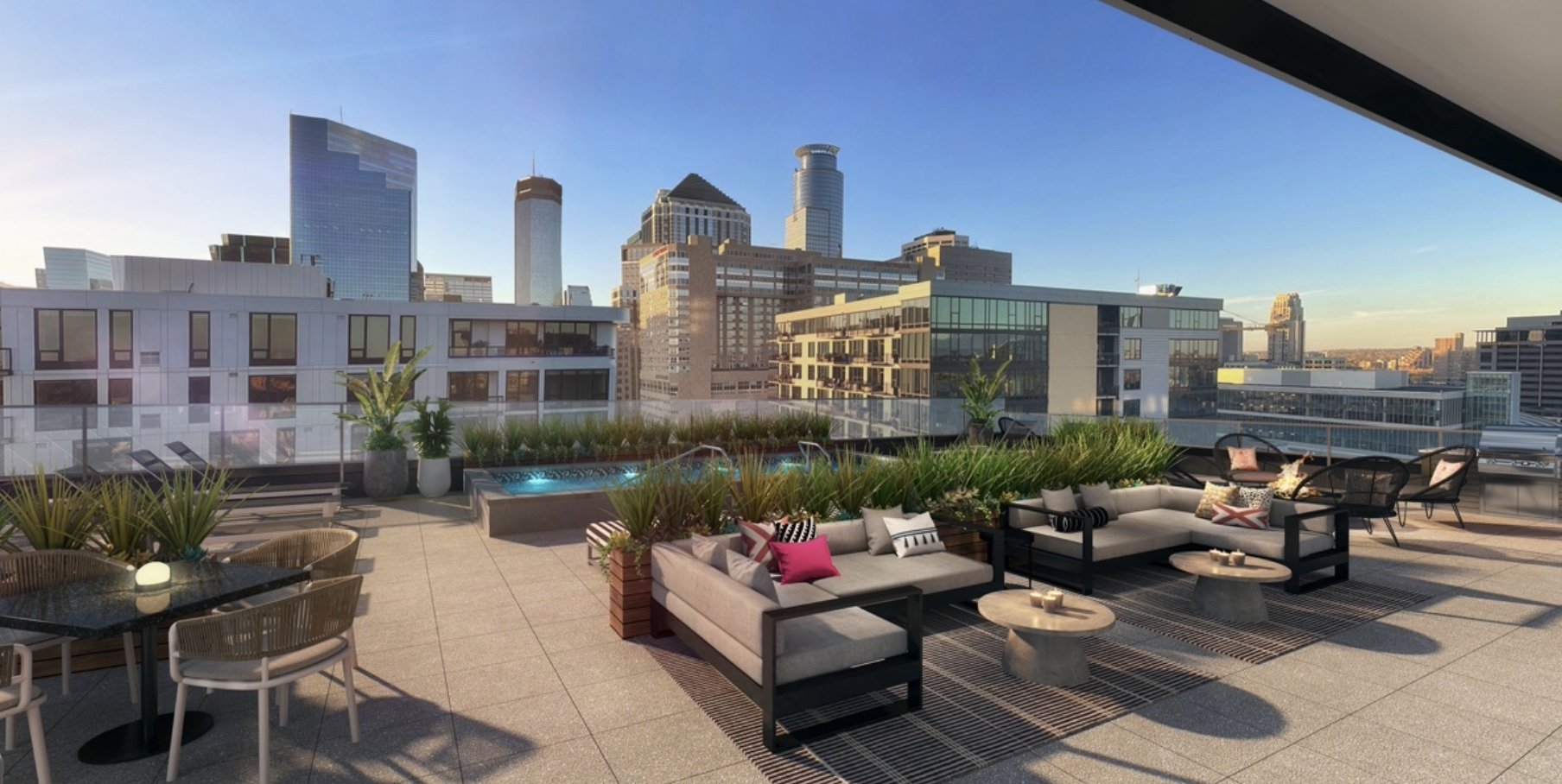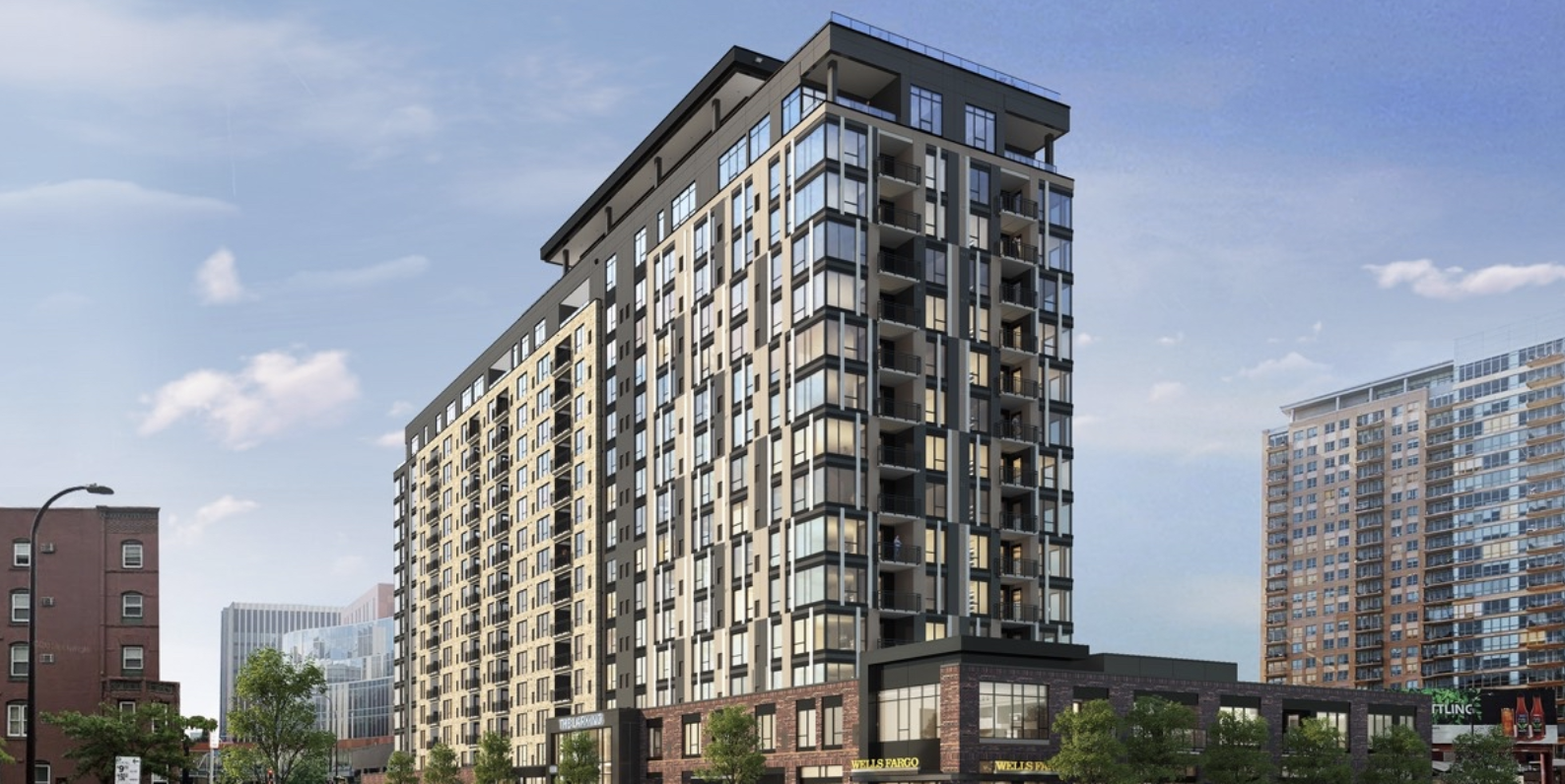The construction firm Kraus-Anderson has been active in the multifamily sector in its home market of Minneapolis-St. Paul, having engaged six such residential projects in the past decade. Its latest completion is The Larking, a $100 million 16-story tower located in Minneapolis’ East Town district.
The 400,714-sf Larking, which ESG Architects designed and Kimley Horn engineered, is a mixed-use development with 341 market-rate apartments and seven penthouses, as well as a one-story Wells Fargo bank branch, 9,100 sf of street-level retail, and three levels of underground parking.

The building is targeting urban professionals with 35 floor plans—from a 402-sf micro apartment leasing for $1,430 per month to a 1,214-sf two-bed two-bath apartment leasing for $3,370, according to its website. Its design features floor-to-ceiling windows, wide-plank flooring, and exposed concrete ceilings and columns. Contributing to its live-work-play environment are a Sky Lounge, pool deck with 360-degree views of downtown, fitness and wellness center, sauna, golf simulator, pet spa, work-from-home suites, conference room, a catwalk library and community table seating, and “creation center.”

Kraus-Anderson provided development and construction services, and is The Larking’s landlord. “We feel The Larking will enhance downtown by bringing new neighbors and commercial offerings to the Elliot Park neighborhood and adding vibrancy to the overall downtown community,” Erica Arne, director of development for Kraus-Anderson, told Twin Cities Business.
Another of Kraus-Anderson’s multifamily projects, MODA at Raymond, a $44 million six-story building in St. Paul with 220 apartments, is scheduled to be completed this summer with 40-plus floor plans available. Ironically, to make way for this construction, a U.S. Bank branch that occupied the property had to come down.
Related Stories
| Nov 7, 2014
Prefab helps Valparaiso student residence project meet an ambitious deadline
Few colleges or universities have embraced prefabrication more wholeheartedly than Valparaiso (Ind.) University. The Lutheran-based institution completed a $27 million residence hall this past summer in which the structural elements were all precast.
| Nov 3, 2014
Novel 'self-climbing' elevator operates during construction of high-rise buildings
The JumpLift system from KONE uses a mobile machine room that moves upward as the construction progresses, speeding construction of tall towers.
| Nov 3, 2014
Cairo's ultra-green mixed-use development will be topped with flowing solar canopy
The solar canopy will shade green rooftop terraces and sky villas atop the nine-story structure.
| Oct 31, 2014
Dubai plans world’s next tallest towers
Emaar Properties has unveiled plans for a new project containing two towers that will top the charts in height, making them the world’s tallest towers once completed.
| Oct 29, 2014
Better guidance for appraising green buildings is steadily emerging
The Appraisal Foundation is striving to improve appraisers’ understanding of green valuation.
| Oct 27, 2014
Studio Gang Architects designs residential tower with exoskeleton-like exterior for Miami
Jeanne Gang's design reinvents the Florida room with shaded, asymmetrical balconies.
| Oct 21, 2014
Passive House concept gains momentum in apartment design
Passive House, an ultra-efficient building standard that originated in Germany, has been used for single-family homes since its inception in 1990. Only recently has the concept made its way into the U.S. commercial buildings market.
| Oct 21, 2014
Perkins Eastman white paper explores state of the senior living industry in the Carolinas
Among the experts interviewed for the white paper, there was a general consensus that the model for continuing-care retirement communities is changing, driven by both the changing consumers and more prevalent global interest on the effects of aging.
| Oct 16, 2014
Perkins+Will white paper examines alternatives to flame retardant building materials
The white paper includes a list of 193 flame retardants, including 29 discovered in building and household products, 50 found in the indoor environment, and 33 in human blood, milk, and tissues.
| Oct 15, 2014
Harvard launches ‘design-centric’ center for green buildings and cities
The impetus behind Harvard's Center for Green Buildings and Cities is what the design school’s dean, Mohsen Mostafavi, describes as a “rapidly urbanizing global economy,” in which cities are building new structures “on a massive scale.”
















